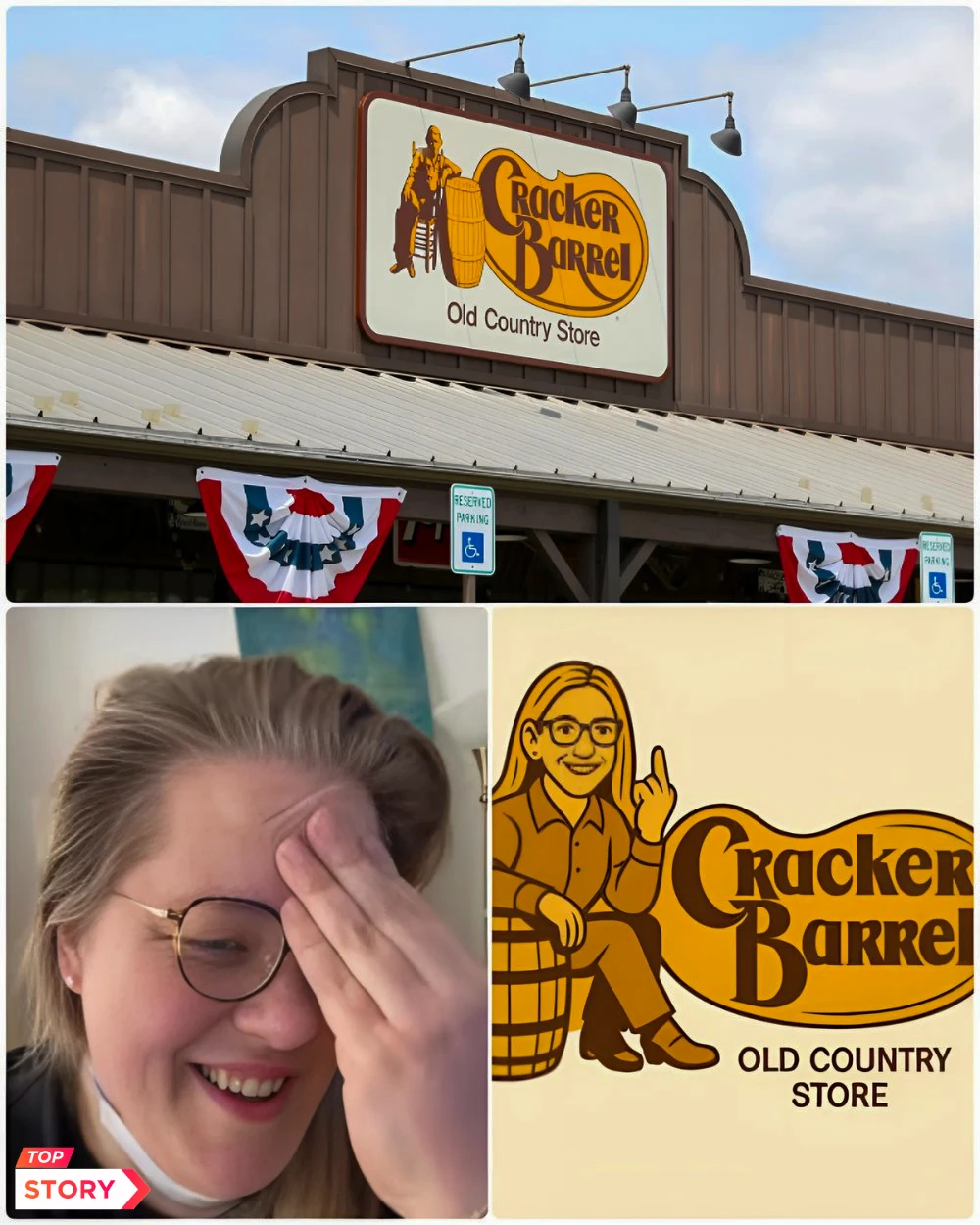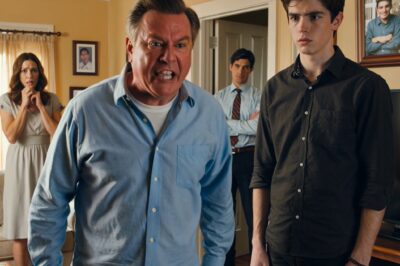
Stock Rebounds After Cracker Barrel’s Costly Collapse: $100 Million WIPED OUT and Its Most Powerful Seat VANISHED Overnight — All Because of One Remark That SHOOK America
$100 million vanished. A powerful seat disappeared into the night. And it all began with one short sentence — a single smirk, a raised hand, and a microphone that never should have been live.
People are still asking: How did a brand built on biscuits, wood chairs, and generational loyalty collapse into chaos — then rebound into one of the most dramatic comebacks Wall Street has seen this year?
From the polished stage lights of a marketing rollout to the dim emergency boardroom in Nashville, every look, every message, every breath held inside corporate headquarters pointed to one chilling truth: the storm wasn’t about the logo. It was about what followed it.
The Rebrand That Backfired — Loudly
Cracker Barrel’s attempt to modernize its brand began, like so many missteps, with good intentions and bad instincts. A sleek new logo was unveiled in early August — clean, sans-serif, painfully generic — and meant to attract a younger demographic.
Instead, it lit a match.
Within hours, TikTok was ablaze with comparisons: “gas station food,” “soulless,” “midwestern Applebee’s.” Twitter (or X) hashtags like #BringBackTheBarrel and #NotMyBiscuits exploded. Influencers mocked the design. Facebook comment sections turned savage.
And the stock? It began to bleed.
Within five days, Cracker Barrel lost over $100 million in value. Analysts compared it to the Bud Light meltdown. One Wall Street blog called it “the most expensive typeface change in history.”
But the true damage wasn’t just graphic. It was verbal.
The Sentence That Shook the Foundation
During a press Q&A meant to smooth investor nerves, CEO Richard Halpern, standing confidently behind the Cracker Barrel podium in Nashville, was asked whether criticism from conservative media — including an Op-Ed from The Oil Times — was causing internal concern.
His answer should’ve been boilerplate.
Instead, he leaned back, gave a dry smile, waved his hand, and said:
“Don’t mind those old folks.”
Six words. No script. No recovery. And no idea what had just detonated.
The Freeze That Followed
A junior PR associate in the room reportedly dropped her tablet.
A senior VP allegedly muttered under his breath, “He didn’t just say that, did he?”
By sunset, the clip had been sliced, subtitled, slowed down, and blasted across every social platform imaginable.
To Halpern, it was a jab at a conservative editorial board. But to the rest of America — and especially to Cracker Barrel’s core base — it read as a direct insult to the very people who had built the brand: older, rural, loyal patrons.
The ones who still wore flannel.
The ones who still drove off the interstate to eat.
The ones who still remembered who Cracker Barrel used to be.
Inside the Emergency Meeting
That night, at 10:47PM, board members gathered behind closed doors. Not to debate. But to react.
“We weren’t just talking about a logo anymore,” one attendee said. “We were talking about trust, and how fast it can vanish.”
Internal chat logs — later leaked to Business Insider — show board members typing versions of:
“Unacceptable.”
“He burned us.”
“Get ahead of this before the market does.”
By 11:30PM, Halpern’s keycard access was revoked.
By 6:15AM, his resignation letter was signed.
By 9:00AM, the official statement hit the press:
“Effective immediately, Richard Halpern has stepped down as CEO of Cracker Barrel.”
No explanation. No apology.
Just silence — and stock movement.
Wall Street Reacts: A Rebound Born From Rejection
And that’s where the twist began.
Within hours of Halpern’s exit, Cracker Barrel’s stock rebounded more than 12%. By Friday, nearly all $100 million lost during the rebrand fiasco had returned.
CNBC’s morning segment opened with the headline:
“Cracker Barrel Cuts the Cord — and Investors Reward Them.”
One analyst said bluntly:
“This wasn’t just about branding. It was about leadership. And investors didn’t believe Halpern had it.”
The Symbolism of Silence
When Halpern was seen leaving his Nashville home the following evening — briefcase in hand, tie loosened, face tight — the symbolism was hard to miss.
He had entered the summer as a visionary reformer.
He left it as a case study in how not to talk to America.
His now-notorious sentence — “Don’t mind those old folks” — had become a rallying cry.
Staff printed the words and taped them above microwaves.
Customers started wearing T-shirts with crossed-out versions of the quote.
It had become the new benchmark of executive arrogance.
Behind Closed Doors: What Staff Really Said
Leaked internal emails showed the emotional impact more clearly.
“He called our best customers irrelevant,” one regional manager wrote. “You don’t recover from that.”
Another wrote simply:
“He didn’t just insult them. He insulted us for caring about them.”
The company’s communications director reportedly burst into tears after Halpern left, not from grief — but relief.
“He made everything feel tight,” one executive whispered. “Tense. Like we were constantly explaining away his smirks.”
The Comeback Begins
On August 26 — just 48 hours after Halpern’s fall, Cracker Barrel issued a final statement:
“We’ve heard our customers. We are returning to the original Cracker Barrel logo, and reaffirming our commitment to the tradition, quality, and hospitality that built our story.”
And just like that, the pressure released.
Customers flooded locations nationwide. Wait times increased. Older guests posted selfies in front of rocking chairs again.
“We’re back,” one 68-year-old diner in Kentucky told local news. “But we never would’ve returned if they’d kept that man.”
What Made the Sentence So Dangerous?
Because it wasn’t just careless.
It was casual cruelty — the kind that doesn’t yell, but shrugs.
The kind that makes people feel forgotten while smiling to their face.
The kind of line that shows the gap between leadership and loyalty.
“It was quiet. But it was loud,” said one former Cracker Barrel VP.
“That’s why it cost him everything.”
The Internet Responds — And Doesn’t Forget
Freeze-frame memes of Halpern’s smirk went viral.
One clip slowed his quote down, added somber piano music, and cut to footage of empty restaurant booths.
The caption?
“Respect is not vintage. It’s vital.”
Hashtags like #OldFolksMatter, #Don’tMindThis, and #HalpernWho trended globally.
A parody TikTok pretending to be Halpern ordering takeout — only to be “refused service by a 70-year-old cashier” — hit 4.2M views in 24 hours.
The Lessons — and the Warning
Cracker Barrel’s rebound may look like a triumph. But it came at a price:
One CEO gone
A full rebrand scrapped
Trust with a core audience badly bruised
And all because of six words no one thought would matter.
But in 2025, they matter more than ever.
The Final Walkaway
Richard Halpern may have left the building.
But his mistake?
It’s burned into every boardroom lesson plan from now on.
“Don’t mind those old folks.”
He thought it was harmless.
He thought the cameras would move on.
He thought the market would forget.
But in an era where a whisper carries louder than a press release, and where every expression becomes a screenshot, Halpern learned the hard way:
A careless remark isn’t just bad optics.
It’s bad business.
Closing Line:
It was supposed to be a modernization.
Instead, it became a masterclass in what happens when a company forgets who brought it this far.
Six words. One man gone. A stock reborn. And a legacy rewritten.
News
A Poor Hotel Cleaner Fell Asleep In a BILLIONAIRE’s Bed — And Everything Changed
A hotel housekeeper fell asleep in a billionaire’s bed—and everything changed. Beatrice “Bea” Torres pushed her housekeeping cart down…
My Dad Yelled, “All You Do Is Take—You’ve Never Given This Family Anything…” In the quiet sprawl of suburban Virginia, Eric had always been the one no one noticed
My Dad Yelled, “All You Do Is Take—You’ve Never Given This Family Anything…” My Dad Yelled, “All You Do…
No Maid Lasted with the Billionaire’s New Wife — Until a New Maid Did the Impossible
No Maid Lasted with the Billionaire’s New Wife — Until a New Maid Did the Impossible She had broken…
Billionaire Finds Homeless Boy Dancing for His Paralyzed Daughter… What Happens Next Will Shock You!
Billionaire Finds Homeless Boy Dancing for His Paralyzed Daughter… What Happens Next Will Shock You! A billionaire father never imagined…
JUST IN: RICH LADY SPLASHES MUD ON CLEANER GIRL — UNAWARE WHO WAS WATCHING
RICH LADY SPLASHES MUD ON CLEANER GIRL — UNAWARE WHO WAS WATCHING What happens when a rich woman humiliates a…
My Dad Yelled, ‘All You Do Is Take—You’ve Never Given This Family Anything!’ Then Told Me to Leave If I Had Any Pride Left. So I Did—Quietly.
My Dad Yelled, ‘All You Do Is Take—You’ve Never Given This Family Anything!’ Then Told Me to Leave If…
End of content
No more pages to load












